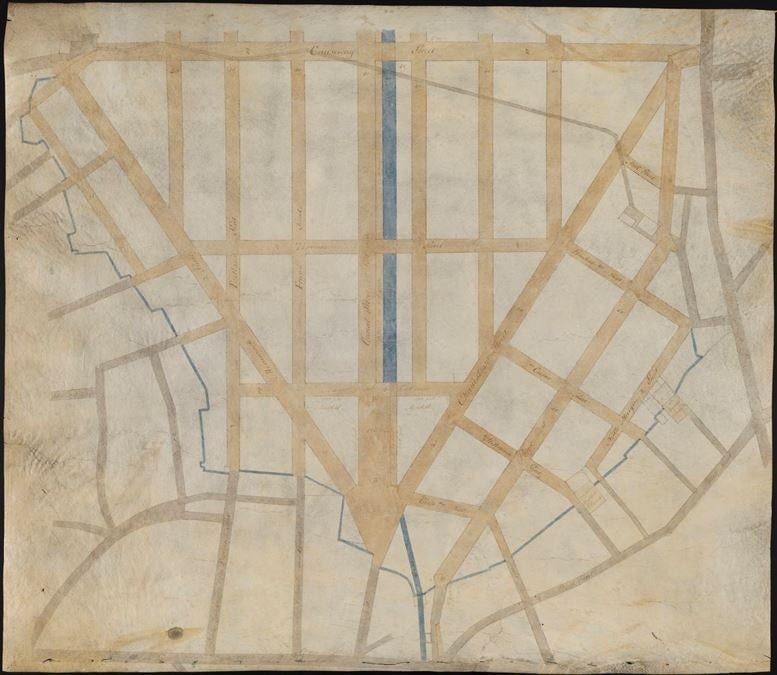Soon, Housing Will Be an ALLOWED Use in the Bulfinch Triangle—Here’s Why That’s a Win!
Now that the City Council has approved this measure with a strong vote (10-2), it is on its way to the Zoning Commission for further consideration.
Boston is a city that thrives while staying true to its roots. Nowhere is that balancing act more apparent than in the Bulfinch Triangle. This area has seen it all—from its days as wetlands known as the Mill Pond, to becoming a vibrant commercial district designed by Charles Bulfinch in 1808, to being cut apart by highways, and now, slowly but surely, making a comeback. We have a chance to embrace that revival and bring new life to an area that has always been a part of Boston’s DNA.
Before the Bulfinch Triangle was developed, it was a tidal basin used both for industry and waste disposal. Mills relied on the tides for hydraulic power, while waste drained into the pond, leading to stagnation and eventual land reclamation. The first major shift came when Beacon Hill was cut down to fill the Mill Pond, laying the foundation for the Bulfinch Triangle’s street grid. That grid, based on the old dam lines, gave the neighborhood its distinctive triangular shape.
Through the 19th century, transportation dictated how the area evolved. In the mid-1800s, stables, blacksmiths, and pedestrian-friendly businesses defined the western edge of the Triangle, while freight depots along the east attracted warehouses and industry. As railroads expanded, the neighborhood shifted again, with the arrival of passenger trains at North Station making it more residential. By the early 20th century, the subway system had reshaped the area yet again, increasing walkability and pushing industry to the outskirts.
The 20th century wasn’t exactly kind to the West End. The elevated John F. Fitzgerald Expressway sliced through the neighborhood, displacing residents and breaking up the community. The automobile boom of the 1920s led to more parking lots and expressways, further eroding the area's livability. For decades, the Triangle was more about lost opportunities than possibilities.
Then came the Big Dig. When the elevated highway was finally taken down, it opened the door for a fresh start. The Rose Kennedy Greenway breathed new life into the area, and now, the Bulfinch Triangle is on the brink of something big. But to truly make the most of this moment, we need to fix outdated zoning rules that are holding us back.
That’s where the text amendment to the Boston Zoning Code, Article 46, Section 9 makes a difference. Right now, residential development in the Bulfinch Triangle is classified as a "conditional use," meaning developers have to jump through extra hoops just to build housing. This isn’t just a minor inconvenience—it slows down projects, discourages investment, and makes it harder to meet our city’s growing housing needs. My amendment changes that by making residential development an "allowed use," cutting red tape and making it easier to get housing built where we need it most.
Why does this matter? Let’s take a real example: 222 Friend Street. A developer originally proposed a life-science/lab building there, but during the community process, residents kept asking for housing instead. This amendment removes that roadblock and signals loud and clear: Boston is serious about tackling our housing crisis!
The Bulfinch Triangle’s architectural character is one of its greatest assets, and my amendment doesn’t touch any of the existing dimensional requirements that preserve that character. Instead, it makes it possible to add housing in a way that fits the neighborhood, keeping its historic charm while meeting today’s needs.
Zoning debates can get heated, but this is one of those rare moments where just about everyone is on the same page. Residents of the Bulfinch Triangle, the local business community and the broader West End support this. The development community supports this. The Boston Planning Department supports this. And after this week’s City Council vote (10-2!), it’s now on its way to the Zoning Commission for final consideration in coming months.
This is how we make smart, sustainable growth happen—by removing outdated barriers while preserving the history of our neighborhoods! The Bulfinch Triangle has been reinvented before, and now it’s time to write its next chapter. Let’s make it one that includes more homes, more opportunities, and a thriving vibrant neighborhood that future generations will be proud of!








Well done. I'm behind you 100%.
Superb proposal and correct recounting the area's history. Congratulations, and more power to you and your staff.